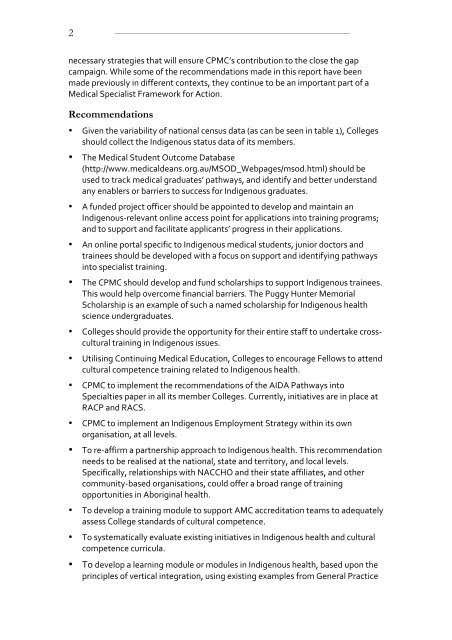View - LIME Network
View - LIME Network
View - LIME Network
Create successful ePaper yourself
Turn your PDF publications into a flip-book with our unique Google optimized e-Paper software.
2necessary strategies that will ensure CPMC’s contribution to the close the gapcampaign. While some of the recommendations made in this report have beenmade previously in different contexts, they continue to be an important part of aMedical Specialist Framework for Action.Recommendations• Given the variability of national census data (as can be seen in table 1), Collegesshould collect the Indigenous status data of its members.• The Medical Student Outcome Database(http://www.medicaldeans.org.au/MSOD_Webpages/msod.html) should beused to track medical graduates’ pathways, and identify and better understandany enablers or barriers to success for Indigenous graduates.• A funded project officer should be appointed to develop and maintain anIndigenous‐relevant online access point for applications into training programs;and to support and facilitate applicants’ progress in their applications.• An online portal specific to Indigenous medical students, junior doctors andtrainees should be developed with a focus on support and identifying pathwaysinto specialist training.• The CPMC should develop and fund scholarships to support Indigenous trainees.This would help overcome financial barriers. The Puggy Hunter MemorialScholarship is an example of such a named scholarship for Indigenous healthscience undergraduates.• Colleges should provide the opportunity for their entire staff to undertake crossculturaltraining in Indigenous issues.• Utilising Continuing Medical Education, Colleges to encourage Fellows to attendcultural competence training related to Indigenous health.• CPMC to implement the recommendations of the AIDA Pathways intoSpecialties paper in all its member Colleges. Currently, initiatives are in place atRACP and RACS.• CPMC to implement an Indigenous Employment Strategy within its ownorganisation, at all levels.• To re‐affirm a partnership approach to Indigenous health. This recommendationneeds to be realised at the national, state and territory, and local levels.Specifically, relationships with NACCHO and their state affiliates, and othercommunity‐based organisations, could offer a broad range of trainingopportunities in Aboriginal health.• To develop a training module to support AMC accreditation teams to adequatelyassess College standards of cultural competence.• To systematically evaluate existing initiatives in Indigenous health and culturalcompetence curricula.• To develop a learning module or modules in Indigenous health, based upon theprinciples of vertical integration, using existing examples from General Practice
















